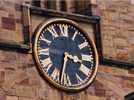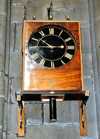For this church:    |
Nottingham St MaryClock
The Tower ClockThe lower lights on the east and west faces of the tower are shortened, and the string mouldings uplifted in the centre, so as to form panels for the two dials of the clock. The original clock was made by Thomas Hardy of Nottingham in 1807, later replaced with one by Cope. The current clock is a 1932 Cope, electric auto-wind, electric chime & strike, ting-tang (2 bell) chime. It was the first of the all-electric Cope clocks ever made and became the Cope standard from 1932 onwards. It was converted from DC to AC in 1959 when the Lace Market was converted. The east facing clock face has a painted mahogany face and the west face is painted lead. The clock chimes sounded in the tower until 1980 when, with the addition of two new ringing bells and major alterations to the frame, the clock hammers were disconnected. An earlier clock made by Rowe of Epperstone and sold to Dr Staunton for his church at Staunton for £10, was situated in the window of the south transept.
|







